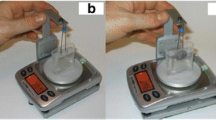Summary
A microdrilling method and apparatus have been developed for the representative sampling of inhomogeneous ancient coins. By drilling through the cylindrical surface of coins a more average sample can be obtained than with surface sampling techniques. This drilling process leaves barely visible holes on the cylindrical surface of the coin, while the faces are unaffected. The technique has been successfully applied to 4th–5th century Roman bronze quadrantes. Preliminary analytical data, obtained by atomic-absorption spectroscopy, energy dispersive X-ray, and wet chemistry, show quite different compositions for the three coins analysed. Photomicrographic examination shows clear evidence of the inhomogeneity and the need for averaging sampling.
Zusammenfassung
Ein Verfahren wurde entwickelt, inhomogene alte Münzen zwecks Gewinnung repräsentativer Proben mit einem Mikroapparat anzubohren. Indem man die Münze an der zylindrischen Seitenfläche anbohrt, erhält man einen besseren Durchschnitt als Probe. So bleibt die ebene Fläche der Münze unversehrt und das Bohrloch kaum sichtbar. Römische Bronzequadranten aus dem 4.–5. Jahrhundert wurden mit Hilfe dieser Technik untersucht. Vorläufige Ergebnisse der Atomabsorptionsspektroskopie, der energiedispersiven Röntgentechnik, der nassen chemischen Untersuchung zeigen eine durchaus verschiedene Zusammensetzung dreier untersuchter Münzen. Die mikrophotographische Untersuchung erweist deutlich die Inhomogenität und damit die Notwendigkeit, Durchschnittsproben zu verwenden.
Similar content being viewed by others
References
I. L. Barnes, W. R. Shields, T. J. Murphy, and R. H. Brill, in Archaeological Chemistry, C. W. Beck (Ed.), Washington DC: American Chemical Society. 1974. p. 1.
M. J. Hughes, M. R. Cowell, and P. T. Craddock, Archaeometry18, No. 1, 19 (1976).
T. Lyman (Ed.), Metals Handbook. Cleveland: American Society for Metals. 1948. p. 1204.
T. Lyman, 1. c, p. 1200.
T. Lyman, 1. c, p. 896.
P. Mayers, L. Van Zelst, and E. V. Sayre, in Archaeological Chemistry, C. W. Beck (Ed.). Washington DC: American Chemical Society. 1974. p. 22.
E. R. Caley, in Art and Technology: A Symposium on Classical Bronzes, S. Doeringer, D. G. Mitten, and A. Steinberg (Eds.), Cambridge, Mass: MIT Press. 1970. p. 45.
E. Gegus, in Die Römische Orgel von Aquincum, M. Kaba, Budapest: Akadémiai Kiadó. 1976. p. 49.
A. A. Gordus and J. P. Gordus, in Archaeological Chemistry, C. W. Beck (Ed.), Washington DC: American Chemical Society. 1974. p. 127.
P. Meyers, L. Van Zelst, and E. V. Sayre, J. Radioanalyt. Chem.16, 67 (1973).
W. J. Young, in Art and Technology: A Symposium on Classical Bronzes, S. Doeringer, D. G. Mitten, and A. Steinberg (Eds.), Cambridge, Mass: MIT Press. 1970. p. 93.
M. Bakos and E. Gegus, Acta Archaeolog. Acad. Sci. Hung.31, 3 (1979).
D. F. Gibbons, K. C. Ruhl, and L. S. Staikoff, in Archaeological Chemistry, C. W. Beck (Ed.), Washington DC: American Chemical Society. 1974. p. 11.
V. Simić, Arch. Iugosl.12, 55 (1971).
G. F. Carter, in Archaeological Chemistry II, G. F. Carter (Ed.), Washington DC: American Chemical Society. 1978. pp. 348–350.
C. S. Smith, in Art and Technology: A Symposium on Classical Bronzes, S. Doeringer, D. G. Mitten, and A. Steinberg (Eds.), Cambridge, Mass: MIT Press. 1970. p. 51.
A. A. Gordus and J. P. Gordus, in Archaeological Chemistry, C. W. Beck (Ed.), Washington DC: American Chemical Society. 1974. p. 126.
Catalog 88, p. 3. Garrett Industrial Supply Co., 550 Virginia Ave., Fort Washington, PA 19034, U. S. A.
W. T. Chase, in Archaeological Chemistry, C. W. Beck (Ed.), Washington DC: American Chemical Society. 1974. p. 174.
H. Lechtman and A. Steinberg, in Art and Technology: A Symposium on Classical Bronzes, S. Doeringer, D. G. Mitten and A. Steinberg (Eds.), (Fig. 35). Cambridge, Mass: MIT Press. 1970. p. 28.
Author information
Authors and Affiliations
Rights and permissions
About this article
Cite this article
Szonntagh, E.L. Sampling method for representative elemental analysis of non-homogeneous coins. Mikrochim Acta 75, 191–205 (1981). https://doi.org/10.1007/BF01196389
Received:
Issue Date:
DOI: https://doi.org/10.1007/BF01196389




